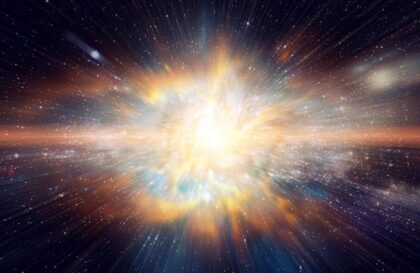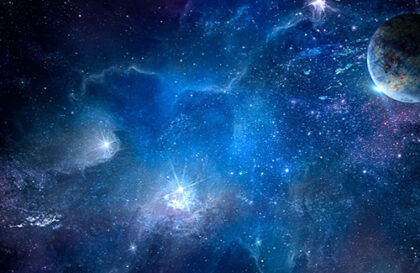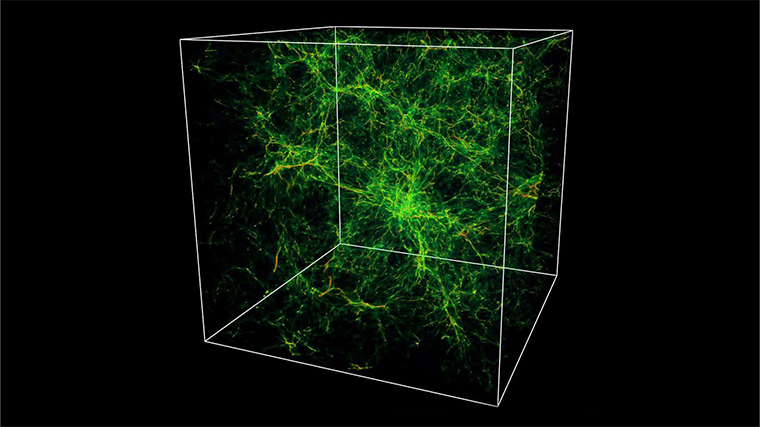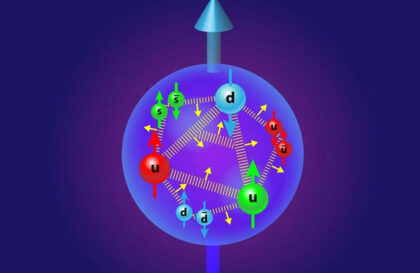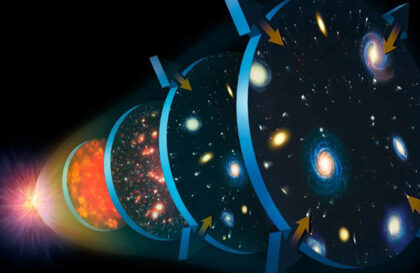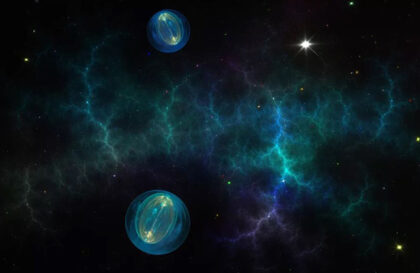“When it comes to matter, we were all wrong. What we have called matter is energy, the vibrations of which are so low that we can perceive it with the help of the senses. Matter does not exist.”
Albert Einstein.
When I read this statement by Einstein, I immediately remembered an unusual but fascinating explanation of the concepts of “energy”, “space”, “and matter”. In the light of Einstein’s quotation, the story looks amazing.
I present it with some abbreviations.
What is energy?
By energy we often mean oil, gas, heat, and electricity in our outlet, one would think of the formula E=mc2.
Einstein believed that everything that we call matter is the same energy, condensed to such an extent that we can observe it.
Let’s fantasize like Einstein.
Imagine a canvas (tablecloth or blanket) that is even and flat. If you squeeze it in some place, you get folds, compaction, clot, and energy. Compression, and change in the space of the Universe are energy. Stars, planets, black holes, gas clouds – these are all bundles of energy of varying degrees of compression, and space density.
The smallest of them are elementary particles, also with different space densities, which determine their properties.
When there are a lot of such particles (nodules), they create strong distortions in the very fabric of space, making it more dense (pulling it together) around them.
The density of space is gravity. That is why it is large for black holes (a lot of energy is compressed in them with a high density) and insignificant for asteroids.
There is no up or down in space. Therefore, harder objects simply fall on top of each other, i.e. attract in our understanding. This is gravity.
Planets and asteroids flying past a larger body with strong gravity, one of their parts (half) falls into a denser space and begins to change its direction towards the object of attraction, like a car that drives its right wheels onto the side of the road with denser soil.
The distortion of light passing near large objects can also be explained using the density of space because light in a dense medium is more distorted. Take a glass lens or a bottle of clear water, the light will also be distorted as it passes through a denser medium.
If you release a lump, a clot, it will straighten out, a wave will go over the surface of the tissue at the speed of light. It compresses and straightens the surface.
A wave is also a compaction of space, but it is not concluded at some point, but propagates in all directions, distorting space. A wave is also energy, a change in space, which means that it also has gravity.
A wave does not have mass as a static quantity, since mass characterizes energy in the form of a particle, i.e. a change in space at one point, and a wave characterizes energy in motion through space. This is not the energy of mass, but the energy of motion.
As energy is emitted by such a bunch, a wave will go (radiation is also energy), the bunches will become less dense, and the matter, as it were, evaporates, i.e. the space of the universe straightens out.
As soon as the last ray of light goes out and the last atom, electron, and everything that is energy, the last wave will die out, and then space itself will disappear, i.e. the whole universe will straighten up.
The Universe moves from one state, which we call Energy, to another state, which we call Space.
And when the system reaches the extreme value – it completely straightens out, it just turns over, and E changes places with P, i.e. energy becomes space, and space becomes energy. This can be called instant compression. And everything starts over.
Something like a swing. All energy is converted into space, then space is converted into energy. And so it always repeats. The universe is cyclical.
Perhaps, now expanding infinitely, scientists have discovered this fact. The universe is expanding, it tends to its original state – it spreads out into a flat tablecloth. Energy turns into Space.
The same can be demonstrated as water – space, a snowflake – a bunch of energy.
What about matter?
Let’s look at a small clot of energy – an atom, a piece of matter, a brick of which all visible matter consists.
An atom, receiving a portion of energy, becomes even denser matter, for example, hydrogen turns into helium, helium into tritium, etc. And giving energy in portions, the atom will “lose” its energy density, the energy clot will decrease, the density of matter will decrease, and the space will become less dense, straightened out.
Energy is not matter, not an object. An atom is an object. Energy can be possessed by objects and groups of objects – this is a property of objects that describes their behavior and their relationships with each other.
Particles or objects moving by themselves through space can have two types of energies: mass-energy (E= mc2, independent of particle motion) and motion energy (this energy is zero for a particle at rest and becomes greater the faster it moves ).
The interaction of particles is better compared with children jumping on a trampoline, each child is a particle, and the trampoline is space, Depending on the mass of the child (particle) and the pace of his jumps (oscillations), waves will propagate through space, and two children jumping to the beat will be able to hold together by the hands and jump on this trampoline, but if their jumps are in resonance, then they will not be able to jump together, and will be repelled.
An electron is such a universal or, one might say, basic particle or wave for energy transfer or interaction between other particles. When an electron is in the orbit of an atom, it is better to say that this is a wave that has a certain amplitude (orbital) depending on the vibration energy, but this vibration is in a closed state, the wave cannot propagate further into space. But when an electron gains or loses energy, its amplitude changes abruptly, as it gains or loses energy in chunks.
That is an electron is a wave or oscillation from the atom itself, and under certain conditions, an atom can lose it, releasing it into space, or vice versa acquire it.
Turning energy into matter?
How was it after the Big Bang?
Protons, neutrons, and electrons are formed in the first minute of the evolution of the Universe. They formed the simplest atoms, hydrogen, and helium. The remaining elements were formed inside the stars as a result of thermonuclear reactions, the expenditure of enormous energies. The heaviest atoms, like uranium, are created when stars explode and eject particles that collide to form new elements.
Billions of years have passed since the Big Bang when elements other than hydrogen and helium were formed as a result of stellar evolution.
So part of the energy of the Big Bang turned into matter.
All elements heavier than hydrogen, helium, and lithium did not arise in the Universe at the time of the Big Bang, but as a result of the gradual processing of three light elements into heavier substances in the depths of stars. Such high temperatures and pressures prevail in the core of the Sun and other luminaries that the nuclei of hydrogen, helium, and lithium can collide with each other and merge, forming a heavier element and releasing energy.
Stars arise from clouds of gas and stardust, i.e. matter from the Big Bang. They flare up when the clot of matter has contracted and compacted enough.
Thermonuclear reactions take place inside the star, converting hydrogen atoms into helium (a denser matter) and energy. Then even denser matter is formed – carbon, oxygen, and nitrogen.
When the star cools, it will explode and eject particles of denser matter formed in it, saturating the Universe with new matter.
Our Sun, for example, consists of: hydrogen 1H = 91%, helium 4He = 8%,
carbon 12C, nitrogen 14N, oxygen 16O ~ 1%, and as it works, its mass decreases – the space straightens out.
Matter on earth
The everyday life of matter on Earth does not look so bright – it is the interaction of quarks (components of protons and neutrons) and leptons (one of the most famous of them is the electron) through electromagnetism. It is at this level that the transformation of energy into matter and vice versa takes place.
The transformation of energetic light into matter is a direct consequence of Einstein’s famous equation E = mc2, which states that energy and matter, or mass, are interchangeable.
Nuclear reactions in the Sun and in nuclear power plants regularly turn matter into energy. By burning firewood on a hike, and gasoline in the engine, we get energy in the form of heat, electricity, and movement by car. For us, the process of converting matter into energy has become familiar.
The reverse process was beyond the power of people for a long time.
Einstein formula. It’s simple
Why?
Energy is described by the famous Einstein formula
E=mc2,
where m is the mass.
Mass describes matter, i.e. the very compression of space. The speed of light is a constant describing the wave (light). We see that energy is characterized by only two parameters – mass and speed of light. This means that energy can be in two states in the form of matter or wave.
There is no space in this formula because energy is space itself. With the advent of energy, space appears.
If you read the equation E=mc2 from right to left, you can see that a small amount of mass produces a large amount of energy due to c2, which is the speed of light squared. This is what we see in photosynthesis. The electron gets a nice kick from a photon at the speed of light.
But if you look at the formula in reverse, you will see that you need to start with a huge amount of energy to get even a tiny amount of mass.
And this is the answer to the question of why we still do not squeeze space in our hands, which is energy, and do not make chairs, laptop tops, cars, and hamburgers from space.
And it would be a good incentive for fitness – the more he squeezed the space with his hand, the more things he squeezed out of it.
And the LHC is proof of that?
The Large Hadron Collider works following Albert Einstein’s famous formula E = mc2, converting matter into energy, and then back, the resulting energy into another form of matter.
But that was until 2018. During the ATLAS experiment at the LHC, it was discovered that photons can transform into W-bosons, elementary particles, i.e. matter. Almost like photosynthesis. This is a cool achievement, yet not having practical use.
During operation, the LHC spends only on the operation of the accelerator 700 GW•h or 10% of the total annual energy consumption of the Canton of Geneva. And only a few elementary particles have been obtained, the mass of which will not even move the arrow of the smallest scales. In addition, the lifetime of W-bosons is about 3⋅10−25 seconds.
Light can be turned into matter
Almost a hundred years ago, in 1934, physicists Gregory Bright and John Wheeler theoretically proved that matter can be obtained from pure light. Sounds like science fiction, but it is quite consistent with Einstein’s famous formula E = mc².
It follows from the equation that if two sufficiently energetic photons or particles of light collide with each other, then you can get matter in the form of an electron and a positron-antimatter, opposite to it.
The main reason why this was not done was the lack of technology. To produce matter from light, the colliding photons must be very high-energy gamma rays. And this can only be done by very powerful gamma lasers (grasers), which do not exist today.
Scientists from the STAR collaboration studying similar phenomena at the RHIC collider at Brookhaven National Laboratory found that the acceleration of gold nuclei (ions) to relativistic speeds (up to 99.995% of the speed of light) and their collision leads to the effect predicted in 1934. After studying the array of data obtained at the RHIC collider, more than 6 thousand facts of photon collisions with subsequent synthesis of matter (electrons and their antiparticles positrons) were discovered.
The first step towards the synthesizer of matter has been made, no matter how fantastic it may sound. But the stumbling block, as always, remains the problem of high energy costs.
Universal factory for the production of things
Let’s fantasize like Einstein again.
Imagine a particle as a single point where energy is concentrated. If its static nature is violated, then this point (sphere) will begin to expand from its center in space, and the energy of the wave will gradually fall, while the radius of the wave will increase, so the energy from the particle will go into the form of a wave that moves through space and in some then the wave will completely disappear, becoming a part of space, the space will become larger or it will become denser, with more energy, i.e. the energy will pass from matter into the form of space.
We can mentally perform the opposite action, compressing space, i.e. taking away part of the energy from it, we will get a wave, continuing the compression we will get a particle or matter, while the total space will become a little less, the universe will seem to shrink a little in size, and since we will have a new particle, matter, the total energy at the point will increase, i.e. there will be a little more gravity or matter.
Matter transforms into energy, and energy is space, so nothing forbids you to perform the reverse action, transforming space into energy and matter.
And since we live in space-energy, we can get energy from space itself, we can get a particle or an atom from space itself by changing it. Of course, this requires super technologies, for example, a 3D photon printer or at least a gamma laser, but it is theoretically possible.
Image credit:
hhttps://justenergy.com
https://www.wondersofphysics.com
https://www.cam.ac.uk
https://www.livescience.com

